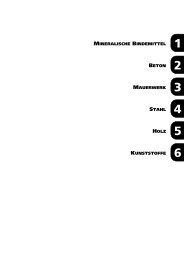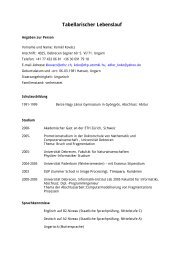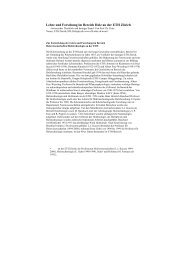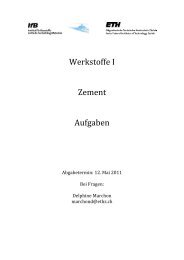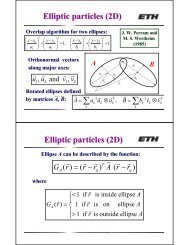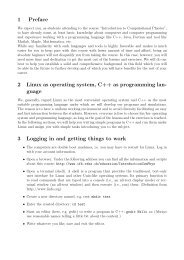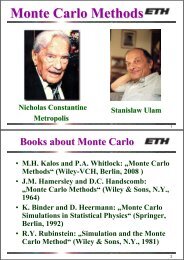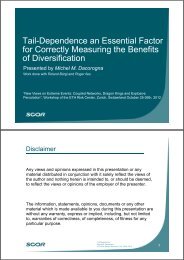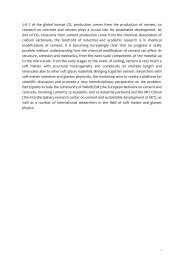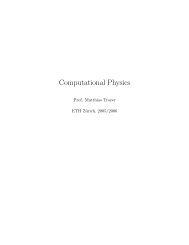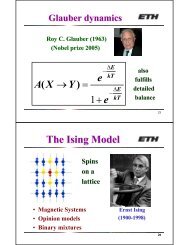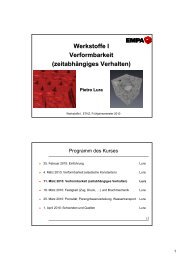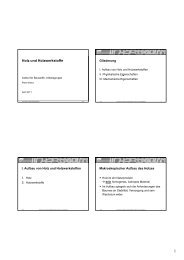Self-avoiding walks - IfB
Self-avoiding walks - IfB
Self-avoiding walks - IfB
Create successful ePaper yourself
Turn your PDF publications into a flip-book with our unique Google optimized e-Paper software.
Random <strong>walks</strong>Semiflexible chainsIdeal chainsNonideal chainsMarkov chainsMartin Kröger www. complexfluids. ethz.ch
Random <strong>walks</strong><strong>Self</strong>-<strong>avoiding</strong> <strong>walks</strong>DiffusionMonte Carlo simulationare essentially problems where an integral has to be determined !
Applications of the random walkIn economics, the "random walk hypothesis" is used to model shares prices andother factors. Empirical studies found some deviations from this theoretical model,especially in short term and long term correlations. See share prices.In population genetics, random walk describes the statistical properties of genetic driftIn physics, random <strong>walks</strong> are used as simplified models of physical Brownian motion andthe random movement of molecules in liquids and gases (diffusion-limited aggregation).Also in physics, random <strong>walks</strong> and some of the self interacting <strong>walks</strong> play a role in quantum field theory.In polymer physics, random walk describes an ideal chain. It is the simplest model to study polymers.In other fields of mathematics, random walk is used to calculate solutions to Laplace's equation,to estimate the harmonic measure, and for various constructions in analysis and combinatorics.In all these cases, random walk is often substituted for Brownian motion.In brain research, random <strong>walks</strong> and reinforced random <strong>walks</strong> are used to model cascadesof neuron firing in the brain.In vision science, fixational eye movements are well described by a random walk.In psychology, random <strong>walks</strong> explain accurately the relation between the time needed tomake a decision and the probability that a certain decision will be made.
Distribution function for the end-to-end vector:To calculate yet unknown Z and α we use1.2.Such that we have expressed both quantities in terms of the meansquared ent-to-end distance
The mean-squared end-to-end-distance is proportional to N sinceValid for all dimensionsPutting the above results together, the distribution function for theend-to-end vector is Gaussian and readsThis is our integrand for a Monte Carlo simulation if we are interestedonly in moments of the distribution function. But what if we are not able tocalculate f(R) by hand (for a more complex model) ?
Random walk via Monte Carlo method ..The program calculates all moments of f(R), i.e. performs all the2N-dimensional integrals and visualizes representative configurations to aprecision which cannot be achieved using classical methods..
A similar code to calculate the end-to-end distribution function f(R)
More applications of the random walkRandom walk can be used to sample from a state space which is unknown or very large,for example to pick a random page off the internet.Often, sampling from some complicated state space also allows one to get a probabilistic estimate of thespace's size. The estimate of the permanent of a large matrix of zeros and ones was the first majorproblem tackled using this approach.In wireless networking, random walk is used to model node movement.Bacteria engage in a biased random walk.Random walk is used to model gambling.During World War II a random walk was used to model the distance that an escapedprisoner of war would travel in a given time.From http://en.wikipedia.org/wiki/Random_walk
Ideal chainsrandom <strong>walks</strong>freely rotating chainswormlike chains
Non-random <strong>walks</strong> 1. Freely rotating chain
Non-random <strong>walks</strong> 2. Wormlike chain modelwhich is the freely rotating chain model in the limitRadius of gyration tensor defined as:.. and can be rewritten as a two-particle (average)Mean squared gyration radius for the wormlike chain readsScattering frommacromolecules
Non-ideal chains:<strong>Self</strong> <strong>avoiding</strong> <strong>walks</strong>
<strong>Self</strong>-<strong>avoiding</strong> <strong>walks</strong> (SAW): Slithering snake algorithm?No??But:
<strong>Self</strong>-<strong>avoiding</strong> <strong>walks</strong> (SAW): Pivot algorithm
Method of enrichedsamples
Method of enriched samples
Method of enriched samples:the main memory-saving ideaadjustmeasurechoose
<strong>Self</strong>-<strong>avoiding</strong> <strong>walks</strong>Scaling behaviorFractal dimension
Fractal dimension df of a walkRandom walk:SAW:df=2 for all dimensions (as we have proven above)df ~ (d+2)/3 with dimension d =1D,2D,3D2/df = 6/4 = 1.5 (D=2)2/df = 6/5 = 1.2 (D=3)
Flory-type argumentfor the self-<strong>avoiding</strong> walkExact (numerical result): 0.588 (5)Extensions, e.g. to polymer brushes or polymer in confinement: simple
Numerical integrationusing random numbersMonte Carlo integrationMarkov chains
Numerical integration via Monte Carlo
in advanceon the flyIndependent of dimension
Hit Monte Carlo
Hit Monte Carloshotscirclediameterarea
Standard Monte Carlo
Monte Carlo feature:Codes are, generally, very short.The code is not much different for high-dimensional integration andintegrands of arbitrary complexity
Monte Carlo in classical statistical physicsWhere do high-dimensional integrals arise?



